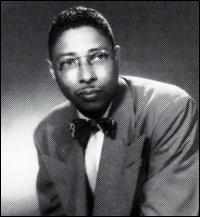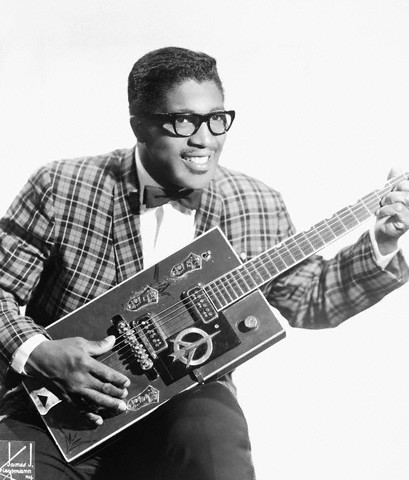 Louis Thomas Jordan[1]
Louis Thomas Jordan[1] (July 8, 1908 – February 4, 1975)
[2] was a pioneering
American musician,
songwriter and
bandleader who enjoyed his greatest popularity from the late 1930s to the early 1950s. Known as "
The King of the Jukebox", he was highly popular with both black and white audiences in the later years of the
swing era. In 2004,
Rolling Stone magazine ranked him no. 59 on its list of the 100 Greatest Artists of All Time.
[3]
Jordan was one of the most successful African-American musicians of the 20th century, ranking fifth in the list of the all-time most successful black recording artists according to
Billboard magazine's chart methodology. Though comprehensive sales figures are not available, he scored at least four million-selling hits during his career. Jordan regularly topped the R&B "race" charts, and was one of the first black recording artists to achieve a significant "
crossover" in popularity into the mainstream (predominantly white) American audience, scoring simultaneous Top Ten hits on the white pop charts on several occasions. After
Duke Ellington and
Count Basie, Louis Jordan was probably the most popular and successful African-American
bandleader of his day.
Jordan was a talented singer with great comedic flair, and he fronted his own band for more than twenty years. He duetted with some of the biggest solo singing stars of his day, including
Bing Crosby,
Ella Fitzgerald and
Louis Armstrong. Jordan was also an actor and a major black film personality—he appeared in dozens of "
soundies" (promotional film clips), made numerous cameos in mainstream features and short films, and starred in two musical feature films made especially for him. He was an instrumentalist who played all forms of the saxophone, but specialized in the
alto, in addition to playing
piano and
clarinet. A productive songwriter, he wrote or co-wrote many songs that became influential classics of 20th-century popular music.
Although Jordan began his career in
big-band swing jazz in the 1930s, he became famous as one of the leading practitioners, innovators and popularizers of "
jump blues", a swinging, up-tempo, dance-oriented hybrid of
jazz,
blues and
boogie-woogie. Typically performed by smaller bands consisting of five or six players, jump music featured shouted, highly
syncopated vocals and earthy, comedic lyrics on contemporary urban themes. It strongly emphasized the rhythm section of piano, bass and drums; after the mid-1940s, this mix was often augmented by
electric guitar. Jordan's band also pioneered the use of
electric organ.
With his dynamic
Tympany Five bands, Jordan mapped out the main parameters of the classic
R&B, urban
blues and early
rock'n'roll genres with a series of hugely influential
78 rpm discs for the
Decca label. These recordings presaged many of the styles of black popular music in the late 1940s, 1950s and 1960s, and exerted a huge influence on many leading performers in these genres. Many of his records were produced by
Milt Gabler, who went on to refine and develop the qualities of Jordan's recordings in his later production work with
Bill Haley, including "
Rock Around The Clock
Commercial success:
In the 1940s, Jordan released dozens of hit songs, including the swinging "
Saturday Night Fish Fry" (one of the earliest and most powerful contenders for the title of "
First rock and roll record"), "Blue Light Boogie", the comic classic "Ain't Nobody Here but Us Chickens", "Buzz Me," "
Ain't That Just Like a Woman (They'll Do It Every Time)", and the multi-million seller "
Choo Choo Ch'Boogie".
One of his biggest hits was "
Caldonia", with its energetic screaming punchline, banged out by the whole band, "Caldonia! Caldonia! What makes your big head so hard?" After Jordan's success with it, the song was also recorded by
Woody Herman in a famous modern arrangement, including a unison chorus by five
trumpets.
Muddy Waters also cut a version. However, many of Jordan's biggest R&B hits were inimitable enough that there were no hit cover versions, a rarity in an era when poppish "black" records were rerecorded by white artists, and many popular songs were released in multiple competing versions.
Jordan's raucous recordings were also notable for their use of fantastical narrative. This is perhaps best exemplified on the freewheeling party adventure "
Saturday Night Fish Fry", a two-part 1950 hit that was split across both sides of a 78. It is arguably one of the earliest American recordings to include all the basic elements of the classic rock'n'roll genre (obviously exerting a direct influence on the subsequent work of
Bill Haley) and it is certainly one of the first widely popular songs to use the word "rocking" in the chorus and to prominently feature a distorted
electric guitar.
[9]
Its distinctive comical adventure narrative is strikingly similar to the style later used by
Bob Dylan in his classic "story" songs like "Bob Dylan's 115th Dream" and "Tombstone Blues". "Saturday Night Fish Fry" is also notable for the fact that it dispenses with the customary instrumental chorus introduction, but its most prominent feature is Jordan's rapid-fire, semi-spoken vocal. His delivery, clearly influenced by his experience as a saxophone soloist, de-emphasizes the vocal melody in favor of highly syncopated phrasing and the percussive effects of
alliteration and
assonance, and it is arguably one of the earliest examples in American popular music of the vocal stylings that eventually evolved into
rap.
Jordan's original songs joyously celebrated the ups and downs of
African-American urban life and were infused with cheeky good humor and a driving musical energy that had a massive influence on the development of
rock and roll. His music was popular with both blacks and whites, but lyrically, most of his songs were emphatically and uncompromisingly "black" in their content and delivery.
Loaded with wry social commentary and coded references, they are also a treasury of 1930s/40s black hipster
slang, and through his records Jordan was probably one of the main popularizers of the slang term "chick" (woman). Sexual themes often featured strongly and some sides—notably the saucy
double entendre of "Show Me How To Milk The Cow"—were so risqué that it seems.
Heres some of his songs




